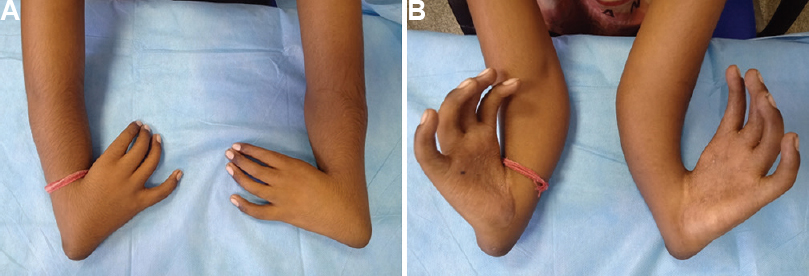Translate this page into:
A differently-abled child with bilateral congenital radial longitudinal deficiency
*For correspondence: slyaiims@yahoo.co.in
-
Received: ,
This is an open access journal, and articles are distributed under the terms of the Creative Commons Attribution-NonCommercial-ShareAlike 4.0 License, which allows others to remix, tweak, and build upon the work non-commercially, as long as appropriate credit is given and the new creations are licensed under the identical terms.
This article was originally published by Wolters Kluwer - Medknow and was migrated to Scientific Scholar after the change of Publisher.
A right-handed 11 yr old male child† presented to the Physical Medicine and Rehabilitation outpatient department, All India Institute of Medical Sciences, New Delhi, India, with hand deformity in February 2018. On examination, bilateral radial longitudinal deficiency (Modified Bayne Type-IV) was found (Fig. 1). X-ray (Fig. 2) also confirmed the clinical findings. A comprehensive hand-rehabilitation emphasizing on hand-function training was followed. At one-month follow up, ten coordinated hand-activities assessment (Disability Assessment Guidelines, The Gazette of India) showed that he was able do all activities with minimal to no assistance. The present case highlighted that even in the most severe form (Type-IV), the patient could write well (Video) and had good hand function which is a rare finding in this rare congenital condition. Hand rehabilitation focusing on exercises to improve hand-function without surgical intervention may show positive results in such selected cases.

- (A) Dorsal aspect and (B) palmar aspect of both hands showing the absence of thumbs bilaterally in a case of congenital bilateral radial longitudinal deficiency.

- X-ray images of bilateral hands and forearm. (A) right hand and forearm in two different views showing bowing of ulnar bone (white arrows), absence of radius (red arrow) and absence of thumb and (B) left hand and forearm in two different views showing bowing of ulnar bone (white arrows), absence of radius (red arrow) and absence of thumb.
 Video available at ijmr.org.in.
Video available at ijmr.org.in.
Conflicts of Interest: None.





